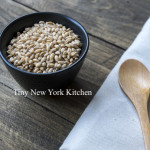Slow Cooker Season
When the weather turns chilly, it’s time to pull out the slow cooker. From hot breakfasts to family dinners and show stopping desserts, using your slow cooker is easy and versatile.
“Work With What You Got!”
©Tiny New York Kitchen © 2019 All Rights Reserved
How To Spot A Whole Grain
To help you when shopping for whole grains, here are the words you should look for in the ingredients list:
It’s A Whole Grain If It’s Called:
Brown (Also Black, Red, Purple) Rice
Buckwheat
Bulgur (Cracked Wheat)
Millet
Quinoa
Sorghum
Triticale
Whole-Grain Corn
Whole Oats And Oatmeal
Whole Rye
Whole Spelt
Whole Wheat
Wild Rice
It’s Not A Whole Grain It It’s Called:
Corn Flour Or Cornmeal
Enriched Flour
Multigrain (This Means Various Grains, Not Necessarily Whole)
Pumpernickel
Rice Or Rice Flour
Rye Flour Or Rye
Stone-Ground Wheat (It Needs To Say “Stone-Ground Whole Wheat”)
Unbleached Wheat Flour
What Or Wheat Flour
Wheat Germ (Not A Whole Grain, but Very Good For You)
Whole Barley (Pearl Barley; Not A Whole Grain, But Very Good For You)
“Work With What You Got!”
© Victoria Hart Glavin Tiny New York Kitchen © 2017 All Rights Reserved
New Year New You Healthy Pantry Staples To Have On Hand
Looking to build healthier eating habits? Remember, you don’t have to change everything all at once. Start with small steps that you can feel good about.
The easiest way to cook healthy is to have the proper items on hand. Healthy pantry staples are key ingredients for making healthy meals. Fill your pantry with these shelf basics and then during the week shop for more perishable foods. Try and buy organic when possible.
Dried Beans & Dried Lentils
Canned Beans (No Salt Added)
Whole Grains
Whole Grain Pasta
Rolled Or Steel-Cut Oats
Canned Diced Tomatoes (No Salt Added)
Low Sodium Vegetable Broth
Unsweetened Plain Soy Milk
Unsweetened Plain Almond Milk
Mellow White Miso
Tahini
Peanut Or Almond Butter (No Salt Or Sugar Added)
Raw Nuts (Almonds, Cashews, Walnuts, Pumpkin Seeds, Sunflower Seeds)
Dried Apricots, Dates & Raisins (No Sugar Added)
Dijon Mustard
Cider Vinegar
Nutritional Yeast
Instead of thinking about what not to eat, think about healthy things that you can add to your diet. Strive to incorporate more greens and colorful vegetables into your meals.
Concentrate on whole foods in their natural forms such as fruits and vegetables.
Whole grains are key. Instead of reaching for regular pasta or white bread, look for varieties made with 100 % whole grain flour. Brown rice, quinoa and barley are good choices as well.
Try steaming your vegetables instead of frying in oil.
Think of beans, whole grains, and vegetables as the main event. Keep lean meat and fish at 3 ounces or less.
Remember, there are no quick fixes. Making healthy choices is a process that lasts a lifetime.
www.tinynewyorkkitchen.com
“Work With What You Got!”
© Victoria Hart Glavin Tiny New York Kitchen © 2016 All Rights Reserved
Constitution Week – Foods of Our Forefathers Part II
Constitution Week – Foods of Our Forefathers Part II
The standard grains included wheat, barley, oats and rye. Finely ground wheat flour, “boulted” or sieved through a fine cloth, was used to make white bread for the rich early in the fifteenth century. Most of the gentry ate what we would call cracked or whole wheat bread. The poor ate bread of coarse-ground wheat flour mixed with oats, ground peas or lentils.
During the ocean crossing to the New World, immigrants subsisted on an even more monotonous diet for weeks. The Mayflower provisions were typical – brown biscuits and hard white crackers, oatmeal, and black-eyed peas, plus bacon, dried salted codfish and smoked herring for animal protein. The only vegetables on the trip were parsnips, turnips, onions and cabbages. Beer was the beverage.
As pilgrims set foot on their new homeland, they hardly knew what to expect. Each brought a stock of basic foods to get them through the first year, as well as a variety of basic utensils and kitchen tools. Also included were the essential accompaniments for whatever they found or could raise when they arrived – a bushel of coarse salt, 2 gallons of vinegar, a gallon of “oyle” and a gallon of aquavite.
Nothing they had been told, however, prepared them for the staggering variety of totally unfamiliar plants that were being used as food by the Indians – corn, sweet potatoes, peppers, pumpkins, squash, sunflower seeds and cranberries were examples. In addition to the strange food, there were strange ways of cooking. In Europe, meat was boiled; the Indians, lacking iron pots, roasted theirs on a spit over a fire. The Indians also had a long, slow cooking process that yielded what we now call Boston baked beans, and they used a fire-heated, rock-lined pit for what we would now call a clam-bake. Where the pilgrims were accustomed to raised wheat bread, the Indians introduced them to corn based spoon bread. Corn also provided hominy, used as a vegetable, and later, of course, as grits. For sweetening, the Indians used maple syrup and honey, as sugar was unknown.
Although many of the food the Pilgrims and other colonists found were totally strange, others had travelled the route before them. The Spanish had brought pigs, which thrived especially in areas where peanuts grew. Peaches and oranges were also native which spread throughout climatically suitable areas in a short time.
Even the white potato was an early migrant to the New World, following a zig-zag route, from its original home in Peru to Spain in 1520, from Spain to Florida forty years later, from Florida to England in 1565, always being treated as a culinary curiosity. By the 1600’s they had become a popular food staple in Ireland, and were carried by Colonists both to New England and Virginia, where they quickly established themselves. There they served as a valuable source of vitamin C, protein and trace minerals, in addition to the starch.
Potatoes, incidentally were significant in another, later migration to America: the climate in Ireland proved so amenable to their culture, and their nutrient content was so high, that many poor Irish farmers grew only potatoes on their small farms. In fact, as fathers subdivided farms for their sons, many found themselves supporting whole families on the potatoes grown on less than an acre of ground, while the family itself lived in a roofed-over ditch. When blight struck in 1845, the sole food source of millions of people literally withered away before their eyes. A half-million of the 8 1/2 million population died of starvation or disease, and 1 1/2 million emigrated to England or America – following the “Irish potatoe.”
Spices were in short supply in America’s earliest days. The English pretty well monopolized the trade with the New World. Within a few years, however, settlers had planted the seeds they had brought or imported, and most had adapted to the climate and were flourishing in orderly rows and patterns in kitchen gardens all along the Atlantic Coast. There were a few – ginger, pepper, cloves, mace, cinnamon, nutmeg, and allspice – that simply couldn’t cope with the weather or soil – and were scarce. Olive oil, lime juice, prunes and saffron were available, but only at high prices.
To Be Continued…










